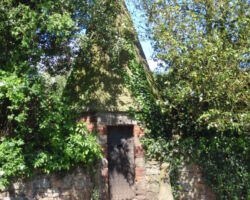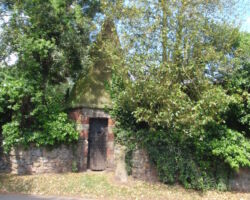DERBYSHIRE LOCK-UPS are historic buildings that were once used to detain people temporarily in England and Wales. They were often used for the confinement of drunks who were usually released the following day or to hold people due to be brought before the magistrates for more serious offences.
Generally they were small stone or brick buildings, often with a conical roof and a single studded door, with narrow slit windows or hole and very occasionally a fireplace. Their regional nicknames included – round house, cage, jug, lobby, watch-house, bridewell, bone-house, blind-house, clink, kitty and cooler
The General Quarter Sessions held at Derby on 12th January 1790 passed the following Court Order: ‘All parishes in the county where there is not already a Round House, House of Correction, or Gaol, shall provide a place of temporary confinement for the reception of vagrants, paupers, felons and the like.’
Later lock ups fell out of use when the County Police Act of 1839 which allowed Justices of the Peace to set up paid Police Forces in each county and also made it compulsory to provide police stations with secure cells.
Fortunatley a few of these old buildings have survived.
During WWII many were used by the Home Guard as sentry posts and arms stores.
Alfreton
Referred to in British Listed Buildings and Historic England as a House of Confinement.
GII
Parish lock-up. Mid C18. Ashlar with shallow pitched roof of large stone slabs plus stone slab ridge stack. Single storey and 2 bays. Gabled street elevation has central semicircular headed doorcase with wide raised surround, raised keystone and studded wooden door. Above is raised plaque inscribed ‘House of Confinement’. To either side there are circular openings with raised plain surrounds. Interior has central corridor with cells to either side. Unusually large example of village lock-up.
To either side there are circular openings with raised plain surrounds. Interior has central corridor with cells to either side. Unusually large example of village lock-up.
Breedon on the Hill – in Leicestershire but close by Ticknall – The Breedon on the Hill Lock-Up is an eighteenth century lock-up is single storey and made of local stone. There is also an open pound to the side of the lock-up. It is located on the main road through Breedon on the Hill on the same side as the war memorial and quarry entrance.
Cromford – from Historic England
CROMFORD 1390 CROMFORD HILL CROMFORD SK 2856-2956 1/78A The Old Village Lock-Up to rear of No.21 Swift’s Hollow II
Lock-Up with keeper’s accommodation above, now a garage and store. 1790. Coursed rubble with ashlar dressings. Slate roof with 2 brick stacks. 2 storey. 5 bay front. Right-hand doorway with plank door, reached up 2 steps with large square lintel. To the left a 2 light flush mullion window, and beyond another similar door and beyond again another 2 light flush mullion window. To the left an inserted pair of garage doors. Above to the right a 2 light window which has lost its flush mullion, and to the left 2 half glazed loft doors. The north-west gable front has an upper 3 light flush mullion window with its original wooden glazing bars. The interior on the ground floor contains 2 lock-up cells with iron doors.
Curbar lockup – Jaggers Keep.
Curbar lockup is unique 18th century building, built around 1780, with an unusual conical-shaped roof. It stands alone in the corner of a field not far from the Cundy Graves north east of Lane Farm. It has just two rooms one up one down. A chimney was built in later years for a fireplace on the ground floor when it was converted into a dwelling and is said to have been inhabited until just prior to the Second World War.
A lot of its history is open to conjecture and is mostly derived from word of mouth although it does appear that the windows have been barred.
As a lock-up is it reputed to have been used to keep prisoners overnight whilst in transit to other gaols or court hearings.
In the Civil War prisoners were said to have been held in the lockup prior to being transported to Sheffield gaol and Sheffield Assizes.
One local tradition says that was used as a pest house. Pest Houses were commonly-owned buildings on the fringes of villages where those struck down with the plague or other infectious ailments could be re-housed until the illness took its course and they either recovered or died. An early form of quarantine really and for Curbar this would have been the ideal spot. Close enough to keep an eye on but far enough away from the main body of the population to avoid contagion. Since it was built around 1780 then it is unlikely that it would have been used to house bubonic plague sufferers but could have taken anyone suffering from a number of ailments which fortunately we don’t see very often today such as leprosy or cholera.
It is known that it was used as domestic accommodation. A sailor known as Francis Pelly lived here and a local deaf-mute named Ebenezer Barratt, known locally as Yebby was the last permanent resident.
In the Civil War prisoners were held in the Curbar lockup prior to being taken to Sheffield gaol.
The property acquired a chimney in later years when it was converted into a dwelling and is said to have been inhabited until just prior to the Second World War.
The building was condemned as unfit for habitation in 1935.
It is a Grade II listed building – from British Listed Buildings –
Description: Lock-up 250 Yards North East of Lane Farm
Grade: II
Date Listed: 12 July 1967
English Heritage Building ID: 81536
Lock-up. Late C18. Coursed rubble gritstone with a conical roof of stepped squared masonry on a square ground floor base. Single bay, two storeys, with a plain doorway with massive surround to the south with plain surrounds. North east elevation has external ashlar stack with stone chimney pot.
Sandiacre – from British Listed Buildings, Historic England and Prison History –
PARISH OF SANDIACRE CHURCH STREET SK 43 NE 2/106 (East Side) Village Lock-Up 10.11.67 and Pound II
Village lock-up and pound. 1660, rebuilt in late C18. Sandstone ashlar with sandstone dressings and pyramidal plain tile roof, plus eaves band. Small square lock-up building about 12 feet high with plank door to west face and two small windows to south face, one above the other. Attached to south side is a tall ashlar wall with rounded copings which curves round to east forming a pound. Over the door is a plaque inscribed ‘Erected as a village lock-up and pound for the imprisonment of stray animals about the year ‘1660 AD’. This is also an Ancient Monument.
Smisby – according to Derbyshire Life – lock-up erected in 1790 is now considered the most typical survival in the county. Known as The Jug, with its conical roof, ball finial, weathered door and polygonal shape, its picturesque charm belies a far grimmer past.
From British Listed Buildings and Historic England –
Lock up. Late C18. Red brick with sandstone dressings. Small
polygonal building with a four-centred arched doorway on the north side with studded plank door. Tall tapering octagonal upper part, of brick with stone bands at the base and the top. Surmounted by a ball finial.
Ticknall
Ticknall’s lock up was constructed with stone, bricks and lime mortar.
The inventory shows; carriage of lime 2s.6d, to John Asher going twice to Melbourne for stones 10s and to Mr G Hutchinson for Lime 18s.9d.
The entries for 10 and 21 October 1809 also records who undertook the work and how long it took. One was Mr G Orton for work at the round house £1 and John Illsley received a total of 14s for 7d for other building work. The village blacksmith, Henry Minion did the iron work and Mr Dickens did the carpentry. The total costs were £25.19.11.
It building became obsolete in 1850 and was used as a Home Guard arms store during the Second World War and since then for storing road sweeping tools. It is now a Grade 11 Listed building.
British Listed Buildings says –
Lock-up. Late C18. Red brick with sandstone dressings. Small octagonal structure with a doorway to south with stone lintel and jambs. Studded plank door. Chamfered stringcourse at the base of the octagonal brick spire. The interior has a fireplace.
Wirksworth
from Prison History –
Information suggests that the building was built as a magistrate’s house in 1842, and then became a police station in 1852. However, when prison inspector Frederick Hill visited on 6 August 1849, he described it as a lock-up house, with cells, and in use as such since 1842. George Victor Townley, the Wigwell Grange murderer, was confined here after his arrest for the murder of Elizabeth Goodwin of Wignell Grange in 1863. When resident in Middleton after the First World War, D.H. Lawrence’s German wife Frieda was required to report at the station each week as an alien. The police station closed in 1952. Now converted into a luxury B&B. One of the former cells has been used as a bathroom for guests staying in The Solicitor’s Room!









